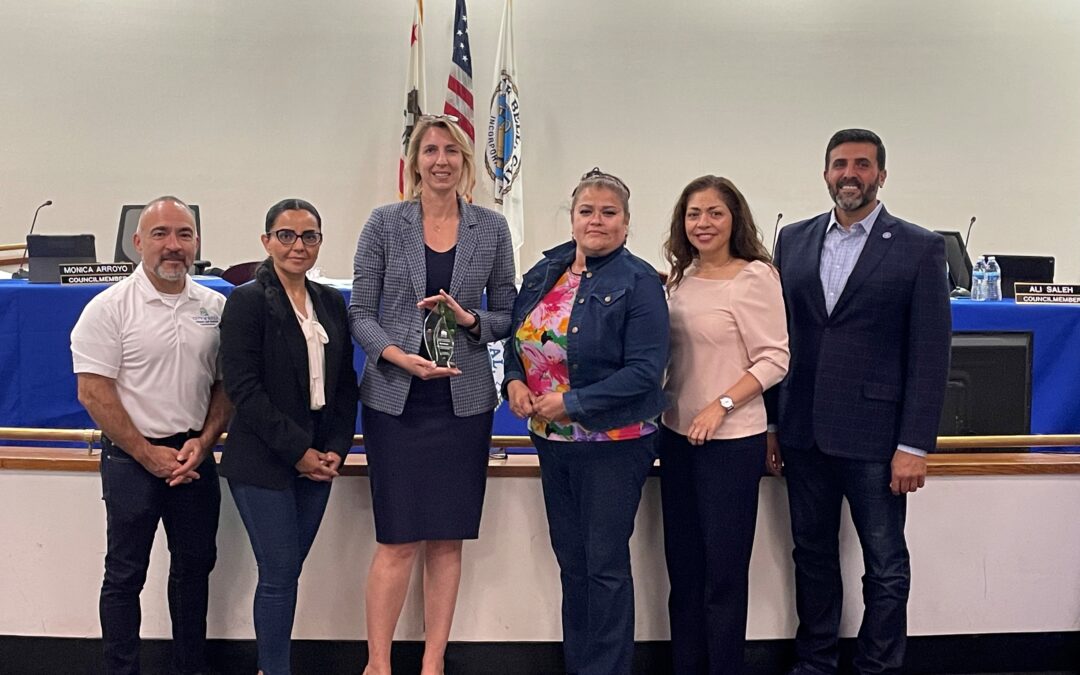Impact Sciences, in partnership with the City of Bell (City), is pleased to accept an Association of Environmental Professionals (AEP) Award of Merit for the preparation of the City’s Environmental Justice (EJ) Element to the 2030 General Plan. The award, presented to the City of Bell on April 11, 2022, at the annual AEP State Conference in Yosemite, CA, celebrates individuals, organizations, and programs advancing diversity, equity, and inclusion (DEI). DEI efforts may include internal workplace initiatives, programs, and policies, and external community engagement. The Bell EJ Element addresses public health risks and environmental concerns for vulnerable populations—which have long suffered public health effects from geographical inequities—and provides consideration of these communities in land use decisions.
Background
The City of Bell is located in the urbanized southeastern Los Angeles metropolitan area, about five and a half miles south of downtown Los Angeles. This industrial and bedroom community region, including the City of Bell, has one of the highest population densities in the United States.
Bell is split between two communities connected along the I-710 Freeway and the Los Angeles River. The northern portion of the City, called the Cheli neighborhood, predominately comprises industrial uses with one homeless shelter, permanent supportive housing, and associated services. The Central City area, located south of Cheli, comprises predominately single-family and low-scale multi-family housing and commercial uses. Environmental considerations for the City include the Bandini Oil Fields located near the Cheli area, the large number of industrial uses in and around Bell, and the I-710 Freeway.
Demographics
Bell is a minority-majority city, with census data showing that its population is more than 93% Hispanic with about 89% of residents speaking a language other than English at home. The City falls below Los Angeles County’s rates in median household income, homeowner occupied housing, and high school education. About a quarter of residents in Bell live below the poverty line. The entire City meets OPR’s definition of a disadvantaged community.
Pollution Exposure
Given its proximity to industrial land uses concentrated in the Cheli area and the I-710 Freeway which runs through the City, pollution exposure is an issue of concern. Such burden is calculated by California Communities Environmental Health Screening Tool (CalEnviroScreen), which analyzes a health score based on 20 indicators by census tract with each census tract within the state assigned a score out of 100 based on these indicators. According to CalEnviroScreen, pollution burden percentile assigned to census tracts within Bell ranges from 82 to 99, among the highest in the region and the state. These indicators include pollution exposure, location of toxic chemicals in or near communities, sensitive populations in a community, and socioeconomic factors. Developing policies and programs to address pollution exposure was key to the EJ Element.
Goals and Policies
The Environmental Justice Element sets forward goals and policies for implementation to enhance the quality of life for Bell’s residents, employees, and visitors. The goals and policies to implement EJ in Bell are explained in the following topic areas:
- Goal 1 – Pollution Exposure and Land Use Compatibility: Exposure to environmental pollution is minimized through good planning and the public process.
- Goal 2 – Public Facilities: Suitable and equitably distributed public facilities available to the entire community.
- Goal 3 – Accessibility to Public Transit, Employment and Services: Affordable, reliable and safe active and public transportation available to all.
- Goal 4 – Safe and Sanitary Homes: A City with safe and sanitary housing conditions and affordable housing options.
- Goal 5 – Civic and Community Engagement: Residents are informed of and actively participate in decisions that affect their environment, communities, and quality of life.
Each section in the EJ Element introduces the topic, outlines key issues, and reviews Bell’s goals and policies related to that subject.
Challenges to Developing the Environmental Justice Element
This Environmental Justice Element encountered some challenges throughout its progress. Its development commenced at the beginning of the Covid-19 pandemic when it was difficult to meet with and reach out to residents for input and feedback due to shelter-in-place restrictions. Despite these challenges, the City remained committed to be transparent throughout this process even with a lack of resources in order to improve trust among its residents. Community surveys, both online and later in person, were distributed to highlight which issues were important to the public in Bell and what goals and policies should be emphasized in the EJ Element. The Element was circulated for public input and review during fall of 2021 and was before the City Council for adoption in spring of 2022.
How the EJ Element Advances Diversity, Equity & Inclusion
The City of Bell’s Environmental Justice Element met AEP’s Advancing Diversity, Equity, and Inclusion criteria by setting a framework for future community development and providing disadvantaged communities with a tool for increasing stakeholder engagement. It is also creating greater public transparency in a city government with limited infrastructure in these areas previously. This EJ Element fills the City’s commitment described in its 2030 General Plan (adopted in 2018), which identifies environmental justice as a key issue for the City and aims for an open, transparent, and collaborative process to promote the full participation of the residents, business owners, and property owners in the planning process. Through the programs being implemented as part of the EJ Element, specifically measures for a community outreach strategy, the City and its residents are more knowledgeable about environmental justice and how it relates to their everyday lives.
Featured Photo: Jessica Kirchner Flores, 2022. Pictured (left to right): Council Member Fidencio Joel Gallardo; Council Member Monica Arroyo; Impact Sciences President/CEO Jessica Kirchner Flores; Mayor Alicia Romero; Vice Mayor Ana Maria Quintana; and Council Member Ali Saleh.


 Brett Pomeroy, Associate Principal, has more than 17 years of professional experience in the environmental planning field with an emphasis in environmental compliance pursuant to CEQA and the National Environmental Policy Act (NEPA). Brett possesses a strong technical background and has provided quantitative analytical modeling support for air quality, GHG, health risk assessments, noise and vibration, and shade/shadow impact analyses for several complex and multi -faceted projects using industry accepted modeling software. Specifically, Brett has experience with AERMOD and ISC air dispersion modeling systems, CalEEMod, URBEMIS, CALINE4-based model, noise modeling based on the Federal Highway Administration’s Traffic Noise Model (TNM), and the Amethyst Shadow Calculator. In addition to providing technical support, Brett conducts environmental analyses for a wide array of environmental issues, conducting land use surveys, ambient noise monitoring, site photography, general environmental research and document management. Brett’s experience includes preparing and managing environmental documentation for both private- and public-sector clients. He has provided environmental analyses to support several types of environmental documents including Categorical Exemptions, Initial Studies, Negative Declarations (NDs), Mitigated Negative Declarations (MNDs), Mitigation Monitoring & Reporting Programs (MMRPs), Environmental Impact Reports (EIRs), and addendums.
Brett Pomeroy, Associate Principal, has more than 17 years of professional experience in the environmental planning field with an emphasis in environmental compliance pursuant to CEQA and the National Environmental Policy Act (NEPA). Brett possesses a strong technical background and has provided quantitative analytical modeling support for air quality, GHG, health risk assessments, noise and vibration, and shade/shadow impact analyses for several complex and multi -faceted projects using industry accepted modeling software. Specifically, Brett has experience with AERMOD and ISC air dispersion modeling systems, CalEEMod, URBEMIS, CALINE4-based model, noise modeling based on the Federal Highway Administration’s Traffic Noise Model (TNM), and the Amethyst Shadow Calculator. In addition to providing technical support, Brett conducts environmental analyses for a wide array of environmental issues, conducting land use surveys, ambient noise monitoring, site photography, general environmental research and document management. Brett’s experience includes preparing and managing environmental documentation for both private- and public-sector clients. He has provided environmental analyses to support several types of environmental documents including Categorical Exemptions, Initial Studies, Negative Declarations (NDs), Mitigated Negative Declarations (MNDs), Mitigation Monitoring & Reporting Programs (MMRPs), Environmental Impact Reports (EIRs), and addendums. Kara Yates Hines, Director of Operations and Publications Manager, leads operations at Impact Sciences and oversees the production and publication of all environmental documents. She has more than 14 years of combined experience in publishing, quality control coordination, science and public health technical writing and editorial review, and digital marketing methodologies. As the primary manager for document production, Kara implements the firm’s operational processes and manages the document publishing flow, including QA/QC review, graphic design, formatting, and visual layout. She leads in-house production of CEQA/NEPA reports, including booklet assembly and digital productions. With a unique understanding of both the CEQA review process and best practices in publishing technically complex documents, Kara ensures the firm’s environmental reports are publicly accessible, easy to read and understand, well organized, and visually appealing. Kara has a masters degree in Publishing from The George Washington University and a bachelors degree in English from Spelman College. She is a member of the Association of Environmental Planners (Los Angeles Chapter).
Kara Yates Hines, Director of Operations and Publications Manager, leads operations at Impact Sciences and oversees the production and publication of all environmental documents. She has more than 14 years of combined experience in publishing, quality control coordination, science and public health technical writing and editorial review, and digital marketing methodologies. As the primary manager for document production, Kara implements the firm’s operational processes and manages the document publishing flow, including QA/QC review, graphic design, formatting, and visual layout. She leads in-house production of CEQA/NEPA reports, including booklet assembly and digital productions. With a unique understanding of both the CEQA review process and best practices in publishing technically complex documents, Kara ensures the firm’s environmental reports are publicly accessible, easy to read and understand, well organized, and visually appealing. Kara has a masters degree in Publishing from The George Washington University and a bachelors degree in English from Spelman College. She is a member of the Association of Environmental Planners (Los Angeles Chapter). Martha Lira, Chief Financial Officer, oversees all aspects of Impact Sciences’ finances, including the development and management of budgets, preparation of financial statements, and all other financial reporting to the firm’s Chief Operating Officer. Martha brings to Impact Sciences over 25 years of business management experience in the public, private, and nonprofit sectors. Prior to joining Impact Sciences, Martha worked for a women-owned CPA firm as a staff accountant, managing small business accounts and tax filing requirements.
Martha Lira, Chief Financial Officer, oversees all aspects of Impact Sciences’ finances, including the development and management of budgets, preparation of financial statements, and all other financial reporting to the firm’s Chief Operating Officer. Martha brings to Impact Sciences over 25 years of business management experience in the public, private, and nonprofit sectors. Prior to joining Impact Sciences, Martha worked for a women-owned CPA firm as a staff accountant, managing small business accounts and tax filing requirements. Lynn Kaufman, Associate Principal, has more than 25 years of experience in both the management and preparation of environmental review documents pursuant to CEQA and NEPA for clients in both the public and private sector. Ms. Kaufman has written numerous CEQA analyses for high profile and environmentally sensitive projects in both urban and rural settings, and acts as a day-to-day contact for in-house and agency staff, subconsultants, and applicants, providing valuable insight to identify environmental constraints and feasible mitigation measures.
Lynn Kaufman, Associate Principal, has more than 25 years of experience in both the management and preparation of environmental review documents pursuant to CEQA and NEPA for clients in both the public and private sector. Ms. Kaufman has written numerous CEQA analyses for high profile and environmentally sensitive projects in both urban and rural settings, and acts as a day-to-day contact for in-house and agency staff, subconsultants, and applicants, providing valuable insight to identify environmental constraints and feasible mitigation measures. Douglas Kim, AICP, Managing Principal, oversees Northern California environmental services for Impact Sciences. His 30-year career includes political, policy, and technical expertise in transportation, air quality, and land use planning. Mr. Kim has prepared and reviewed CEQA and NEPA documents for land use and transportation projects and authored guidance documents on how to perform air quality analyses for two air pollution control districts. He has performed noise, vibration, climate change, and traffic impact analyses for over 100 CEQA environmental analyses throughout California. Mr. Kim has developed long- and short-range multi-modal transportation plans, including performing alternatives analyses, and managing technical modeling. He has managed preparation of air quality plans, developed air quality regulations, climate action plans, and performed air quality analysis and dispersion modeling for land use plans and development projects throughout the state.
Douglas Kim, AICP, Managing Principal, oversees Northern California environmental services for Impact Sciences. His 30-year career includes political, policy, and technical expertise in transportation, air quality, and land use planning. Mr. Kim has prepared and reviewed CEQA and NEPA documents for land use and transportation projects and authored guidance documents on how to perform air quality analyses for two air pollution control districts. He has performed noise, vibration, climate change, and traffic impact analyses for over 100 CEQA environmental analyses throughout California. Mr. Kim has developed long- and short-range multi-modal transportation plans, including performing alternatives analyses, and managing technical modeling. He has managed preparation of air quality plans, developed air quality regulations, climate action plans, and performed air quality analysis and dispersion modeling for land use plans and development projects throughout the state. John R. Anderson, M.A., M.Phil., is Associate Principal for the Northern California-Oakland office. With more than 30 years of experience, John brings to Impact Sciences extensive knowledge of the regulatory, environmental health and safety, and environmental planning industries. He has a long track record for managing large environmental programs and projects across North America. Most recently, John has focused his attention on the Corrections, Education, Energy and Water planning and compliance markets. In California, he has managed the Environmental Planning Program for the Los Angeles Unified School District; prepared Program EIRs for various water authorities and school districts; performed due diligence for public and private sector clients in real estate and corporate acquisitions; and has been retained as an expert witness in relation to school, transportation, and remediation projects. John has a seasoned familiarity with project management, staff development, and financial and administrative management. He’s provided strategic leadership for projects in the areas of CEQA/NEPA environmental impact reporting, risk management, preliminary endangerment assessments, Phase I and follow-on invasive site investigations, litigation support, QA/QC programs, public participation programs, and site safety programs. Impact Sciences is proud to have John as a vital member of our firm.
John R. Anderson, M.A., M.Phil., is Associate Principal for the Northern California-Oakland office. With more than 30 years of experience, John brings to Impact Sciences extensive knowledge of the regulatory, environmental health and safety, and environmental planning industries. He has a long track record for managing large environmental programs and projects across North America. Most recently, John has focused his attention on the Corrections, Education, Energy and Water planning and compliance markets. In California, he has managed the Environmental Planning Program for the Los Angeles Unified School District; prepared Program EIRs for various water authorities and school districts; performed due diligence for public and private sector clients in real estate and corporate acquisitions; and has been retained as an expert witness in relation to school, transportation, and remediation projects. John has a seasoned familiarity with project management, staff development, and financial and administrative management. He’s provided strategic leadership for projects in the areas of CEQA/NEPA environmental impact reporting, risk management, preliminary endangerment assessments, Phase I and follow-on invasive site investigations, litigation support, QA/QC programs, public participation programs, and site safety programs. Impact Sciences is proud to have John as a vital member of our firm. Jessica Kirchner, AICP, President, also serves as the Managing Principal for the firm. Jessica’s corporate responsibilities include contract compliance and financial management with an eye toward strategic growth. Jessica has more than two decades of project work in CEQA/NEPA compliance and places an emphasis on meeting client needs and providing real-world solutions to common CEQA pitfalls. A hands-on owner, Jessica frequently serves in multiple roles on projects, including contract and project manager, as well as conducting and writing environmental analyses all while overseeing the firm’s most high-profile clients, revenue and growth of the firm. With a background in journalism, Jessica’s emphasis on clear, concise documents that are not overly complicated has become a company hallmark, along with the ability to deliver projects on unbelievably tight deadlines. She is highly skilled at taking technical documents and concepts and translating them into reader-friendly concepts.
Jessica Kirchner, AICP, President, also serves as the Managing Principal for the firm. Jessica’s corporate responsibilities include contract compliance and financial management with an eye toward strategic growth. Jessica has more than two decades of project work in CEQA/NEPA compliance and places an emphasis on meeting client needs and providing real-world solutions to common CEQA pitfalls. A hands-on owner, Jessica frequently serves in multiple roles on projects, including contract and project manager, as well as conducting and writing environmental analyses all while overseeing the firm’s most high-profile clients, revenue and growth of the firm. With a background in journalism, Jessica’s emphasis on clear, concise documents that are not overly complicated has become a company hallmark, along with the ability to deliver projects on unbelievably tight deadlines. She is highly skilled at taking technical documents and concepts and translating them into reader-friendly concepts.